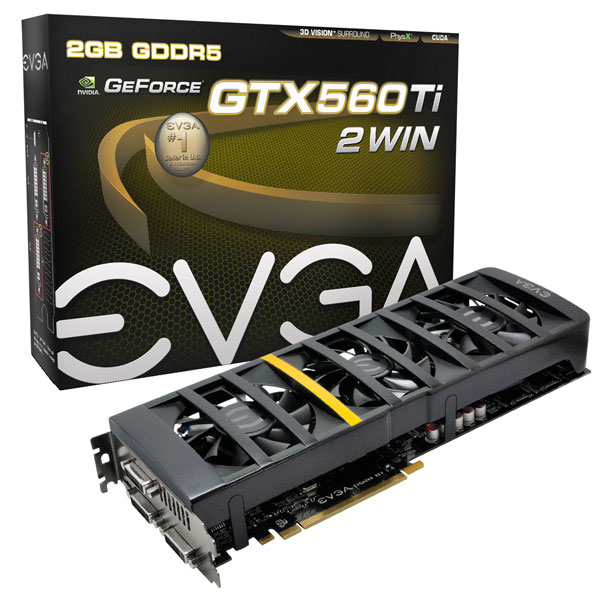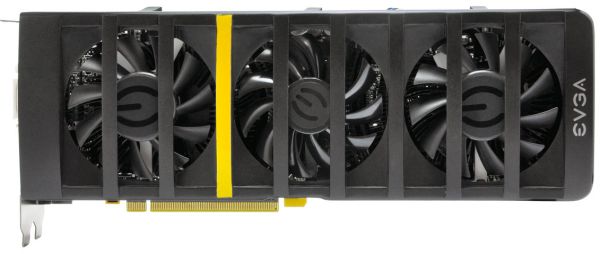EVGA's GeForce GTX 560 Ti 2Win: The Raw Power Of Two GPUs
by Ryan Smith on November 4, 2011 11:00 PM ESTBack at CES 2011 EVGA showed off an interesting concept card featuring 2 GF104 GPUs on a single board. NVIDIA has long designed multi-GPU cards using their high-end GPUs to carve out a market segment above their top single-GPU cards, but while NVIDIA promotes SLI across almost the entire GeForce spectrum it’s promoted as a multi-card option for anything other than those halo cards. Over the years a handful of AMD and NVIDIA’s board partners have struck out on their own and designed their own multi-GPU boards, and at CES 2011 EVGA joined that club.
The resulting product was the EVGA GeForce GTX 460 2Win, which combined 2 overclocked GTX 460s onto a single board. Unfortunately for EVGA, NVIDIA launched the GTX 560 Ti and its associated GF114 GPU mere weeks after CES 2011. GF104 was (and still is) a very capable GPU, but at the end of the day GF114 allowed the GTX 560 Ti to offer a 30% performance improvement for only a very slight increase in power consumption. The GTX 460 2Win did well enough for EVGA to continue with the design, but like the GTX 460 itself, it was clear that the 2Win design was never going to reach its full potential with GF104.
So now in November of 2011 EVGA is back with their next 2Win card: the EVGA GeForce GTX 560 Ti 2Win. Having replaced the GF104 GPUs with GF114 and tweaked the board to handle the extra power consumption, EVGA is giving it another shot. And this time they’re gunning for NVIDIA’s flagship single-GPU card, the GTX 580. Their proposition? For only a little more than the GTX 580 they can offer 30% better performance.
| EVGA GTX 560 Ti 2Win | GTX 580 | GTX 570 | GTX 560 Ti | |
| Stream Processors | 2 x 384 | 512 | 480 | 384 |
| Texture Address / Filtering | 2 x 64/64 | 64/64 | 60/60 | 64/64 |
| ROPs | 2 x 32 | 48 | 40 | 32 |
| Core Clock | 850MHz | 772MHz | 732MHz | 822MHz |
| Shader Clock | 1700MHz | 1544MHz | 1464MHz | 1644MHz |
| Memory Clock | 1002MHz (4008MHz data rate) GDDR5 | 1002MHz (4008MHz data rate) GDDR5 | 950MHz (3800MHz data rate) GDDR5 | 1002Mhz (4008MHz data rate) GDDR5 |
| Memory Bus Width | 2 x 256-bit | 384-bit | 320-bit | 256-bit |
| VRAM | 2 x 1GB | 1.5GB | 1.25GB | 1GB |
| FP64 | 1/12 FP32 | 1/8 FP32 | 1/8 FP32 | 1/12 FP32 |
| Transistor Count | 2 x 1.95B | 3B | 3B | 1.95B |
| Manufacturing Process | TSMC 40nm | TSMC 40nm | TSMC 40nm | TSMC 40nm |
| Price Point | $519 | $489 | $329 | $229 |
EVGA advertises the GTX 560 Ti 2Win as a dual GTX 560 Ti card, and true to their word that’s what it is. It’s an important distinction to make between the 2Win and ultra high end mutli-GPU cards like the GTX 590 and Radeon HD 6990, as both of those are a best effort to squeeze two high-end GPUs into a single card while staying within a 375W power budget under normal operation. The end result is that NVIDIA and AMD have to heavily bin GPUs to find those that will perform at a suitably low voltage, and even then these cards aren’t clocked as high as the single-GPU behemoths they’re based on.
The 2Win on the other hand is exactly what it says on the label. Composed of 2 GF114 GPUs, the 2Win is a GTX 560 Ti SLI setup on a single card, with all of the specs and none of the compromises we see in ultra high end cards. In fact the 2Win is a factory overclocked card, if only slightly – its 850MHz core clock is a mild 3% higher than the 822MHz core clock of the baseline GTX 560 Ti, while the memory clock is identical at 1002MHz (4008MHz data rate). This is paired with 2GB of GDDR5, which is reduced to 1GB of effective VRAM due to the dual-GPU nature of the card.

When it comes to power consumption EVGA doesn’t officially specify a TDP for the 2Win, but given that it’s designed to be a true dual GTX 560 Ti its power requirements closely trend the GTX 560 Ti SLI. In this case that puts the load TDP around 340W, not accounting for any efficiencies gained from having 2 GPUs on a single card or the power consumption of a PCIe bridge chip. As a result this is fairly close to the GTX 590 and Radeon HD 6990, both of which are heavily binned to stay under 375W.
But the real story here of course is the performance for the price. We’ve seen the performance of the GTX 560 Ti SLI in the past, and the performance is quite remarkable. For some time now a pair of NVIDIA’s mid-tier video cards in SLI have been able to surpass a single high-end card, and this performance is the basis of the 2Win. EVGA promotes the 2Win as being more than 30% faster than the GTX 580 and this is something that’s easily achieved in games where SLI scales well.
At the same time the 2Win is priced close to the GTX 580 to further cement its competitive status. EVGA has put the MSRP of the 2Win at $519, which is anywhere between $50 more expensive than the very cheapest GTX 580 to roughly the same price as factory overclocked models. Ostensibly this makes the 2Win more expensive than the GTX 580, but not significantly so given that we’re talking about the high-end video card market. Overall this puts the 2Win in a very good position versus the GTX 580, so long as it can deliver on its 30% performance claims over the GTX 580.
Next to its performance against the GTX 580, the other uses EVGA are using to promote the 2Win are the benefits derived from having multiple GPUs on a single card: namely NVIDIA Surround support. As with the GTX 590, by having 2 GPUs on a single card EVGA can team together the display outputs on the GPUs to drive up to 4 displays, versus 2 displays on a single GPU. This gives the 2Win the ability to drive a triple monitor surround setup on its own, and with 2 GTX 560 Ti GPUs should have the horsepower to do so in most cases. 3D Vision Surround is also a viable possibility thanks to the 3 DL-DVI ports, but the performance hit from 3D Vision is likely more than the 2Win can handle.
Ultimately the 2Win’s status as a multi-GPU card composed of GTX 560 Tis puts it in a unique place. Next to the GTX 580, its only other meaningful competitors are the Radeon HD 6950 CF, and the regular GTX 560 Ti in SLI. The bad news for the 2Win is that these are both cheaper options than the 2Win – you’re paying a price premium to get it on a single card.











56 Comments
View All Comments
Leyawiin - Saturday, November 5, 2011 - link
Its like putting small skinny tires on a Corvette.Leyawiin - Saturday, November 5, 2011 - link
Such a dork..."wouldn't". There goes my funny analogy down the toilet. :(ypsylon - Saturday, November 5, 2011 - link
I stick with my lovely MSI TF3 580. So what it is slower than 2 560. I don't need that kind of power anyways. And just look at this EVGA monstrosity. I would take that for free even if someone paid me good money to take it. Absolute disgrace.EVGA should do the engineering part and then at least slap Arctic Cooling thingy on it. That what companies without imagination do. As for MSI or Asus. You pay a good premium on those, but my god these cards are marvels of modern engineering. Not some slap-dash services a la EVGA.
RussianSensation - Saturday, November 5, 2011 - link
MSI TF3 580 is a marvel of engineering? How so?At $499, it's not fast enough on its own for 2560x1600 gaming in modern games. At 1920x1200 or below, it's not providing more playability than a $300 GTX570. And the fact that you can get 2x HD6950 2GB Sapphire Dirt 3 Edition cards that have a high chance of unlocking into a 6970 makes a pretty poor value atm.
Fiah - Saturday, November 5, 2011 - link
- that SLI scaling will always be strong, and that multi-GPU timing issues are easily overcomeThose are rather strong assumptions. I'm particularly uncertain that the GPU guys will solve micro-stuttering. Micro-stuttering doesn't lose you any benchmarks and it's a complex problem, so I'm rather sceptical if any of the GPU bakers will spend the necessary time and moeny to solve this problem, if indeed it's solvable at all.
Death666Angel - Saturday, November 5, 2011 - link
I see SLI/CF as acceptable in the high end region (HD6950+/GTX570+), where you can't increase performance with one card only. However, even then you need at least a 2560 resolution and other stuff to make really good use of it, because of the console limiting visual performance today.Overall though, I'm not a fan of multi-GPU setups today, because of the driver issues and most importantly micro lag. I had a HD3870X2, 2 GTS8800 512MB and recently gamed on a friends 2*470GTX and the experience was never smooth enough to justify the cost and power consumption.
Isn't PCIe 3.0 supposed to bring better synchronisation to multi-GPU setups? If that happens and if games become more demanding (next console generation?) I might think about SLI/CF again.
But a good test nonetheless. :D
Death666Angel - Saturday, November 5, 2011 - link
It is only below any SLI setup. It is still well above the 6950CF/6970CF setups which are better and/or cheaper.Cihao - Saturday, November 5, 2011 - link
Would be possible to put 2 EVGA GeForce GTX 560 Ti 2Win in SLI, thus fitting 4 GPUs in a dual SLI config?mfenn - Saturday, November 5, 2011 - link
The article specifically says that you can't do thatGrandal - Sunday, November 6, 2011 - link
where i've skimmed it 3 times and still missed it